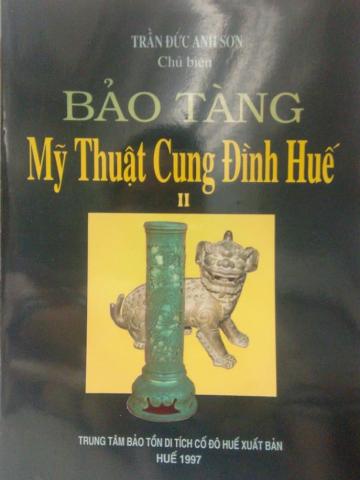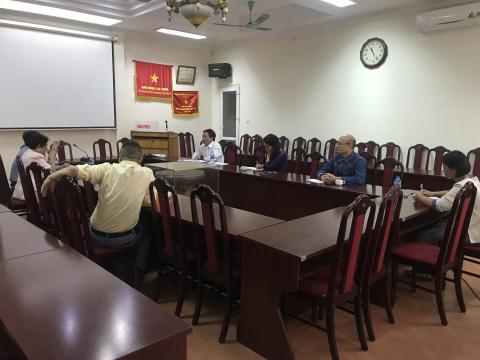- Số trang: 93 trang (kèm theo phụ lục ảnh)
- Năm xuất bản: 1997
Nội dung cuốn sách: cuốn sách tập hợp gồm nhiều bài viết khác nhau của nhiều tác giả khác nhau về các vấn đề liên quan đến bảo tàng như: lịch sử của bảo tàng, kiến trúc điện Long An, nghệ thuật pháp lam, đồ đồng thời Nguyễn và sưu tập đồ đồng ở Bảo tàng Mỹ thuật cung đình Huế, về những cuốn cổ thư, trang phục , tổng quan về đồ sứ ký kiểu thời Lê - Trịnh và thời Nguyễn, trang phục cung đình thời Nguyễn qua sưu tập y phục trong Bảo tàng, trang phục vua chúa thời Nguyễn v.v...
Xin trân trọng giới thiệu!
Các bệnh không lây nhiễm (NCD) là nguyên nhân chính gây tử vong dân số trên toàn thế giới. Nguyên nhân của các bệnh này thay đổi theo các nhóm dân số, và có thể là hậu quả trực tiếp của lối sống bất lợi. Tuy nhiên, khuynh hướng di truyền cũng là một yếu tố góp phần trong một vài quần thể dân số so với những quần thể khác. Các quần thể dân số như Đông Á, Đông Nam Á và Quần đảo Thái Bình Dương cho thấy tỉ lệ cao các bệnh liên quan đến trao đổi chất, và mối liên hệ nguồn gốc mật thiết với nhau gợi ý một khía cạnh di truyền đằng sau sự phổ biến của các bệnh không lấy nhiễm đặc trưng cho vùng rộng lớn này. Như vậy, thật quan trọng để tìm ra các yếu tố khác nhau có thể ảnh hưởng đến các biểu hiện của chúng.
Mục đích của nghiên cứu này là để tìm ra nguồn gốc và tính cổ của các bệnh không lây nhiễm thông qua việc đánh giá hai bệnh lý khớp: bệnh phì đại xương tự phát lan tỏa (DISH) và bệnh ăn mòn khớp (gout). Những bệnh này có mối liên quan duy nhất với hội chứng chuyển hóa và có thể được quan sát thấy trên xương. Các bộ sưu tập xương cho nghiên cứu trên sẽ đến từ các địa điểm khảo cổ ở Thái Lan, Việt Nam và Trung Quốc có niên đại 6.000-5.000 BP đến 1.500-1.600 BP. Nhìn chung, nghiên cứu này thực hiện cách tiếp cận tiến hóa để đánh giá quá trình môi trường và văn hóa cổ góp phần vào sự thích ứng của con người ở mức độ sinh học như thế nào và các phản ứng thích nghi này sau đó được biểu hiện như thế nào ở vấn đề sức khỏe của các nhóm quần thể dân số hiện đại.
Nghiên cứu có những kết quả bước đầu ở hai địa điểm tại Thái Lan : Khok Phanom Di (~2000-1500 BC) và Non Ban Jak (~300-500AD) với tỉ lệ các bệnh ăn mòn khớp lần lượt là 5% và 9 %, bệnh DISH chỉ gặp ở địa điểm Khok Phanom Di với tỉ lệ 7%.
Trong giai đoạn tiếp theo, nghiên cứu sẽ thực hiện ở Vietnam:ConCoNgua (~4000-3000 BC) và ManBac(~1500-1800BC).
và ở Trung Quốc : Yinxu (~1250-1046 BC)
Đồng thời sẽ tìm ra mối liên quan giữa các bệnh DISH, gout với các chỉ số cơ thể như đường kính chỏm xương đùi, chiều dài xương chày và xương đùi, các kích thước đo đốt sống.
1 số biểu hiện của bệnh DISH và gout
Bệnh gai xương phì đại lan tỏa vô căn (DISH).
- Cốt hóa dọc phía bên cột sống
- Biểu hiện dạng “sáp nến”
- đặc biệt liên quan đến vùng đốt sống ngực
- > 4 đốt sống bị ảnh hưởng
- Giữ chiều cao cột sống
- Hình thành dây chằng cột sống

Bệnh ăn mòn khớp (gout)
- Vỡ phần vỏ xương cứng được xác định rõ, với
các cạnh nhô ra và ranh giới xơ cứng.
- Ảnh hưởng tới các khớp hoạt dịch
- Sự phân bố không đối xứng trên cơ thể (ảnh hưởng chỉ một bên trái hoặc phải)
- Thường ảnh hưởng đến đốt ngón chân cái
- Đặc biệt ảnh hưởng đến nam hoặc nữ cao tuổi

Một số kết quả bước đầu của nghiên cứu
| Địa điểm | Niên đại (BP) | n | Ăn mòn khớp | DISH |
| Non Ban Jak | 1500 | 65 | 9% | 0% |
| Khok Phanom Di | 4000 | 59 | 5% | 7% |
| Teouma site, Vanuatu | 3000 | 20 | 35%T | - |
| 45 | - | 42%i | ||
| Wairau Bar, New Zealandx | 700 | 41 | 15% | |
| Chamorros, Guamy | 700 | - | 5.6% | - |
| Wells Cathedral, UK* | 600 | 121 | - | 9% |
| Old Royal Mint Site, UK* | 500 | 152 | - | 4% |
| Các quần thể dân số hiện đại+ | n | Gout |
| Anh | - | 3.22% |
| Đài Loan bản địa | - | 11.7% |
| Thái Lan | - | 0.16% |
| New Zealand Maori | - | 8.8% |
- from Rogers and Waldron (2001), T Buckley (2007), I Foster et al. (2018), x Buckley (2010), + from Kuo et al. (2015), y Rothschild and Heatcote 1995.
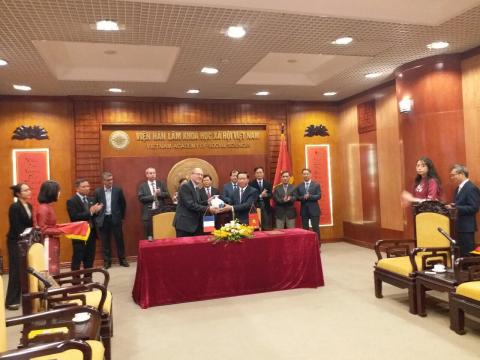
Ký kết Hợp tác nghiên cứu khoa học giữa Viện Khảo cổ học và EFEO
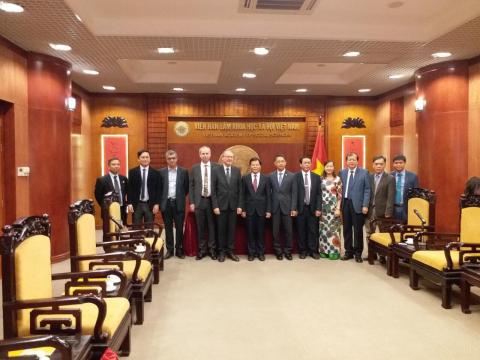
Lãnh đạo Viện Hàn lâm Khoa học xã hội Việt Nam và EFEO tại buổi ký kết hợp tác
Trường Viễn Đông Bác Cổ Pháp (EFEO) là đơn vị nghiên cứu khoa học có bề dày lịch sử thuộc Bộ Giáo dục Đại học và Nghiên cứu của Pháp. EFEO có nhiệm vụ tìm hiểu các nền văn minh cổ ở Châu Á và đã hợp tác cùng nhiều tổ chức nghiên cứu ở nhiều quốc gia về các lĩnh vực Sử học, khảo cổ học, ngôn ngữ, văn hóa, nhân học... Từ 2005 đến nay Viện Khảo cổ học và EFEO đã phối hợp thực hiện một số dự án nghiên cứu khảo cổ học ở các tỉnh Quảng Ngãi và Bình Định.
Hai bên đánh giá nghiên cứu khảo cổ học ở Việt Nam và Sri Lanka có nhiều tư liệu để chỉ rõ quá trình biến đổi khí hậu và thích ứng của con người từ Tiền sử cho đến ngày nay, thương mại hàng hải Ấn Độ Dương - Đông Nam Á, ảnh hưởng của Phật giáo... Kết thúc buổi làm việc, hai bên thống nhất cùng nhau thúc đẩy mối quan hệ hợp tác trong nghiên cứu khảo cổ học giữa các nhà khảo cổ học hai nước và sớm ký kết văn bản hợp tác chính thức.
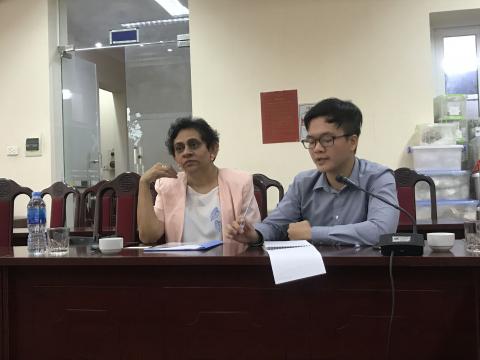
Đại sứ Hasanthi Urugodawatte Dissanayake giới thiệu về khảo cổ học tại Sri Lanka
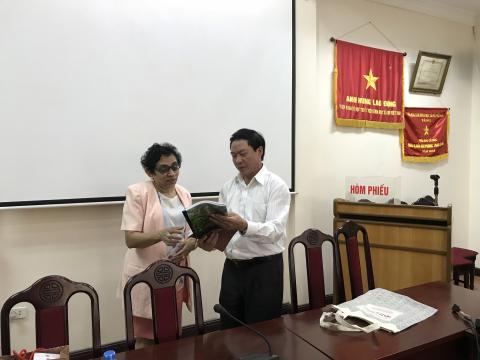
TS Nguyễn Gia Đối giới thiệu về khảo cổ học tại Việt Nam và tặng sách, tạp chí
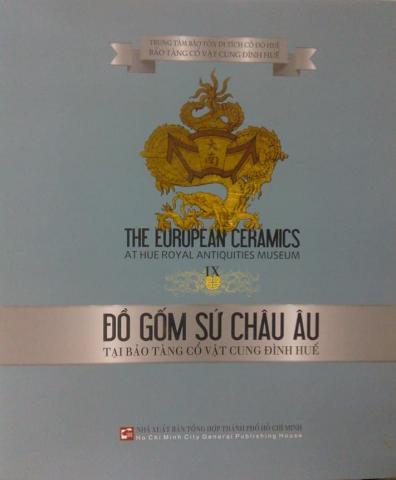 ác giả: Bảo tàng cổ vật cung đình Huế - Trung tâm Bảo tồn di tích cố đô Huế
ác giả: Bảo tàng cổ vật cung đình Huế - Trung tâm Bảo tồn di tích cố đô Huế- Nxb: Tổng hợp TP.Hồ Chí Minh
- Khổ sách: 23 x 25cm
- Số trang: 250 trang
Từ các nguồn thông tin tư liệu nước ngoài của nhà ngiên cứu Philippe Trương (một chuyên gia giám định cổ vật quốc tế, đồng thời là tác giả của nhiều bài viết, ấn phẩm về đồ gốm sứ Việt Nam đã được công bố ở Việt Nam và nước ngoài), kết hợp với kết quả khảo sát nhóm hiện vật có nguồn gốc Châu Âu tại Bảo tàng cổ vật vật cung đình Huế sẽ mang đến cho độc giả những kiến thức tổng hợp không chỉ liên quan trực tiếp đến nhóm cổ vật mà còn làm sáng tỏ mối liên hệ giữa cổ vật với phong tục tập quán, văn hóa, chính trị, ngoại giao qua từng giai đoạn lịch sử của triều Nguyễn.
Xin trân trọng giới thiệu!!
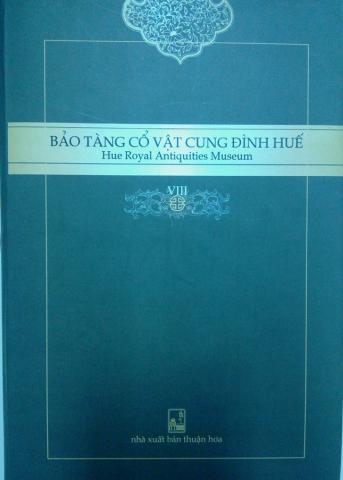 iả: Trung tâm Bảo tồn di tích cố đô Huế
iả: Trung tâm Bảo tồn di tích cố đô Huế- Nxb: Thuận Hóa - 2016
- Khổ sách: 15 x 21cm
- Số trang: 367 trang
Nội dung cuốn sách: Sau tập VII với nội dung: Văn hóa cung đình Huế qua góc nhìn cổ vật thì tập VIII này sẽ đi sâu giới hiệu bạn đọc những nghiên cứu về đồ gỗ cung đình Huế từ tư liệu đến hiện vật. Các chuyên mục: Những vấn đề chung, giới thiệu cổ vật và trao đổi nghiệp vụ - Thông tin tư liệu được trình bày trong cuốn sách này sẽ mang đến cho độc giả những kết quả nghiên cứu khá công phu về lịch sử, văn hóa triều Nguyễn của các nhà nghiên cứu, nhà sưu tầm - phục chế cổ vật cùng những kinh nghiệm nghiệp vụ của đội ngũ cán bộ ở Bảo tàng cổ vật Cung đình Huế.
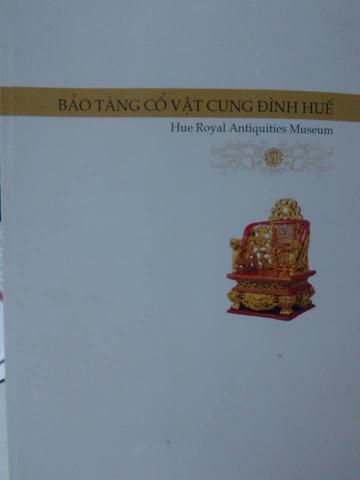 ả: Trung tâm Bảo tồn di tích cố đô Huế
ả: Trung tâm Bảo tồn di tích cố đô Huế- Khổ sách: 19 x 27cm
- Số trang: 229 trang
Nội dung cuốn sách:
Năm 2015, sách Bảo tàng cổ vật cung đình Huế - tập VII sẽ giới thiệu những vấn đề về văn hóa cung đình Huế qua góc nhìn cổ vật với các mục: Những vấn đề chung, cổ vật cung đình Huế và Trao đổi nghiệp vụ. Đây là tập hợp những kết quả nghiên cứu khá công phu và những ý kiến trao đổi từ góc độ chuyên môn của các nhà quản lý, các nhà nghiên cứu, nhà sưu tầm - phục chế cổ vật ở nhiều nơi trên cả nước cùng những kinh nghiệm nghiệp vụ của đội ngũ cán bộ ở Bảo tàng cổ vật Cung đình Huế.
Phù điêu nữ thần Durga (Mỹ Sơn, Quảng Nam, thế kỉ 10-11) bằng đá sa thạch đang được trưng bày tại bảo tàng Chăm-Đà Nẵng
Con tàu dài 23m có tuổi đời hơn 2.400 năm được tìm thấy còn nguyên vẹn dưới đáy Biển Đen.
Các nhà khảo cổ học thuộc Dự án khảo cổ hàng hải Biển Đen (BSMAP) đã tìm thấy xác tàu được cho là cổ nhất còn nguyên vẹn dưới lòng Biển Đen, tờ The Guardian ngày 23/10 đưa tin.

Con tàu vẫn còn nguyên cột buồm, bánh lái và mái chèo. (ẢNH CHỤP MÀN HÌNH THE GUARDIAN).
Xác tàu dài 23m nằm cách mặt nước khoảng 2km vẫn còn nguyên cột buồm, bánh lái và các tấm ván ngang để ngồi chèo. Giới chuyên gia cho rằng điều kiện thiếu oxy ở độ sâu đó đã giúp bảo quản con tàu còn nguyên vẹn.
Đây được cho là tàu buôn có từ thời Hy Lạp cổ đại cách đây hơn 2.400 năm, cùng loại với con tàu được vẽ trên chiếc bình sứ Siren Vase đang được trưng bày ở bảo tàng Anh.
Nhóm tìm kiếm cho biết sẽ để nguyên con tàu ở đó và chỉ lấy một mẩu nhỏ để xác định niên đại tại Đại học Southampton (Anh). Kết quả cho thấy đây là xác tàu cổ nhất còn nguyên vẹn mà loài người tìm thấy, theo BSMAP.
Giáo sư khảo cổ hàng hải Jon Adams thuộc BSMAP cho rằng một con tàu thời cổ đại được tìm thấy nguyên vẹn ở độ sâu đó là điều chưa từng được nghĩ đến. “Phát hiện này sẽ thay đổi quan niệm của chúng ta về nghề đóng tàu và hàng hải thời cổ đại”, ông Adams nói. Dữ liệu về khám phá mới của BSMAP sẽ được công bố tại hội nghị ở London trong tuần này.
(Theo Thanh niên)
Theo đó Phòng Tổ chức - Hành chính, Phòng QLKH-KHTC&HTQT, Ban chủ nhiệm dự án chịu trách nhiệm tổ chức lựa chọn nhà thầu đảm bảo tuân thủ các quy định hiện hành của Nhà nước. Nội dung chi tiết vui lòng xem file đính kèm.

